Installation Prerequisites on CentOS
To successfully install and deploy a Paragon Automation cluster, you must have a control host that installs the distribution software on a single node or on multiple cluster nodes. You can download the distribution software on the control host and then create and configure the installation files to run the installation from the control host. You must have Internet access to download the packages on the control host. You must also have Internet access on the cluster nodes to download any additional software such as Docker, and OS patches.
The order of installation tasks is shown at a high level in Figure 1.

Before you download and install the distribution software, you must configure the control host and the cluster nodes as described in this topic.
Prepare the Control Host
The control host is a dedicated machine that orchestrates the installation and upgrade of a Paragon Automation cluster. It carries out the Ansible operations that run the software installer and install the software on the cluster nodes as illustrated in Figure 2.
You must download the installer packages on the Ansible control host. As part of the Paragon Automation installation process, the control host installs any additional packages required on the cluster nodes. The packages include optional OS packages, Docker, and Elasticsearch. All microservices, including third-party microservices, are downloaded onto the cluster nodes. The microservices do not access any public registries during installation.
The control host can be on a different broadcast domain from the cluster nodes, but you must ensure that the control host can use SSH to connect to all the nodes.
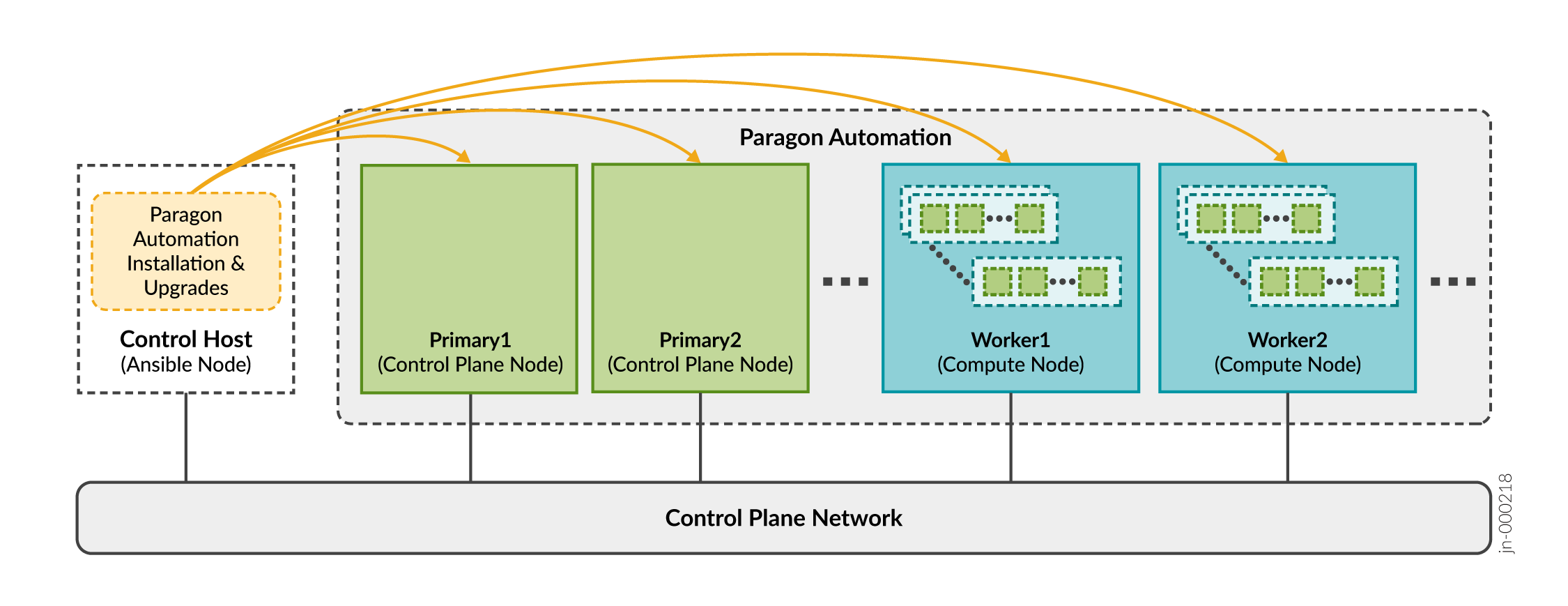
After installation is complete, the control host plays no role in the functioning of the cluster. However, you'll need the control host to update the software or any component, make changes to the cluster, or reinstall the cluster if a node fails. You can also use the control host to archive configuration files. We recommend that you keep the control host available, and not use it for something else, after installation.
You need to prepare the control host for the installation process as follows:
Prepare Cluster Nodes
The primary and worker nodes are collectively called cluster nodes. Each cluster node must have at least one unique static IP address, as illustrated in Cluster Nodes Functions. When configuring the hostnames, use only lowercase letters, and do not include any special characters other than hyphen (-) or the period (.). If the implementation has a separate IP network to provide communication between the Paragon Automation components, as described in the overview section, the IP addresses in that separate network do not need to be reachable outside the cluster. However, then you must assign a second set of IP addresses to the worker nodes. These IP addresses enable devices outside the cluster to reach the worker nodes and also enable communication between:
- Paragon Automation and the managed devices
- Paragon Automation and the network administrator
We recommend that all the nodes be in the same broadcast domain. For cluster nodes in different broadcast domains, see Load balancing configuration for additional load balancing configuration.
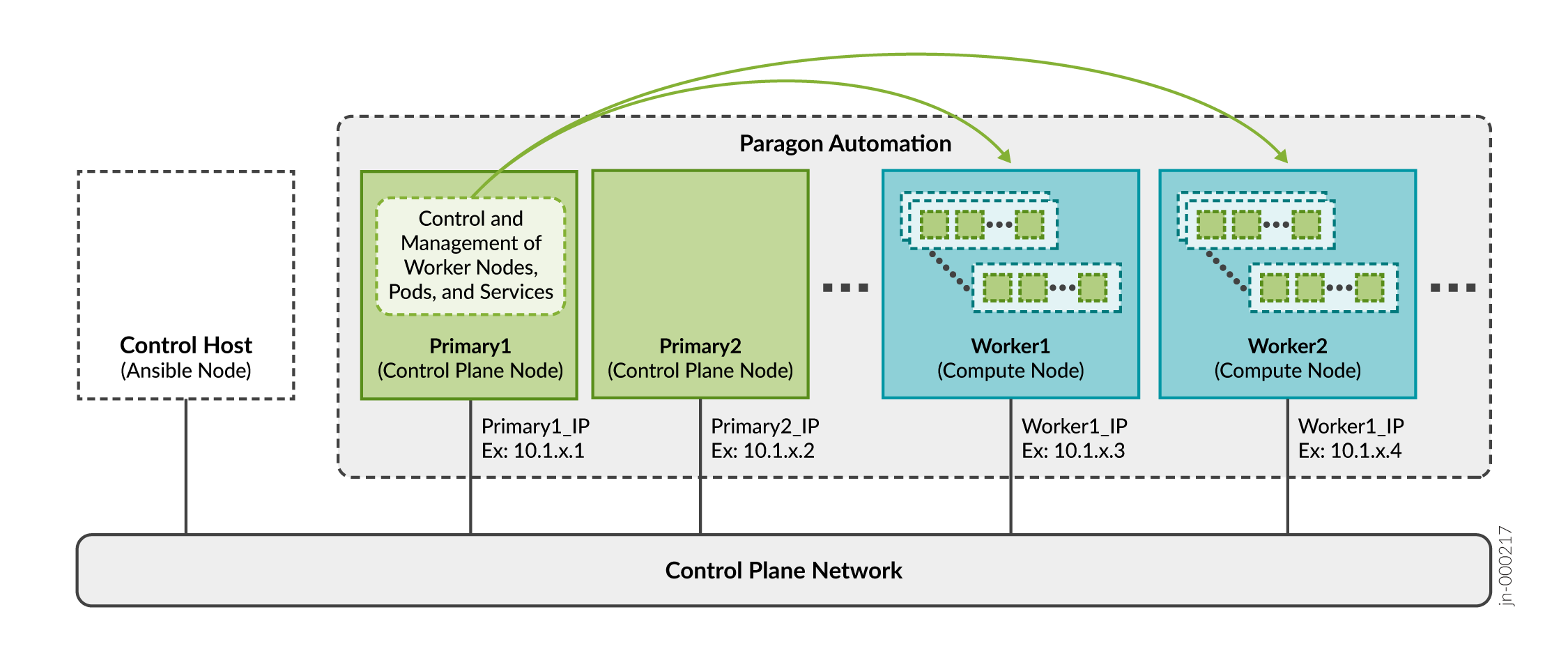
As described in Paragon Automation System Requirements, you can install Paragon Automation as a single node or a multinode deployment. The node installation prerequisites are the same for both multinode and single-node deployments, except for storage requirements.
You need to prepare the cluster nodes for the Paragon Automation installation process as follows:
Virtual IP Address Considerations
A pod is the smallest deployable unit of computing created and managed in Kubernetes. A pod contains one or more containers, with shared storage and network resources, and with specific instructions on how to run the applications. Containers are the lowest level of processing, and you execute applications or microservices in containers.
The primary node in the cluster determines which worker node will host a particular pod and containers.
You implement all features of Paragon Automation using a combination of microservices. You need to make some of these microservices accessible from outside the cluster as they provide services to end users (managed devices) and administrators. For example, you must make the pceserver service accessible to establish PCEP sessions between provider edge (PE) routers and Paragon Automation.
You need to expose these services outside of the Kubernetes cluster with specific addresses that are reachable from the external devices. Because a service can be running on any of the worker nodes at a given time, you must use virtual IP addresses (VIPs) as the external addresses. You must not use the address of any given worker node as an external address.
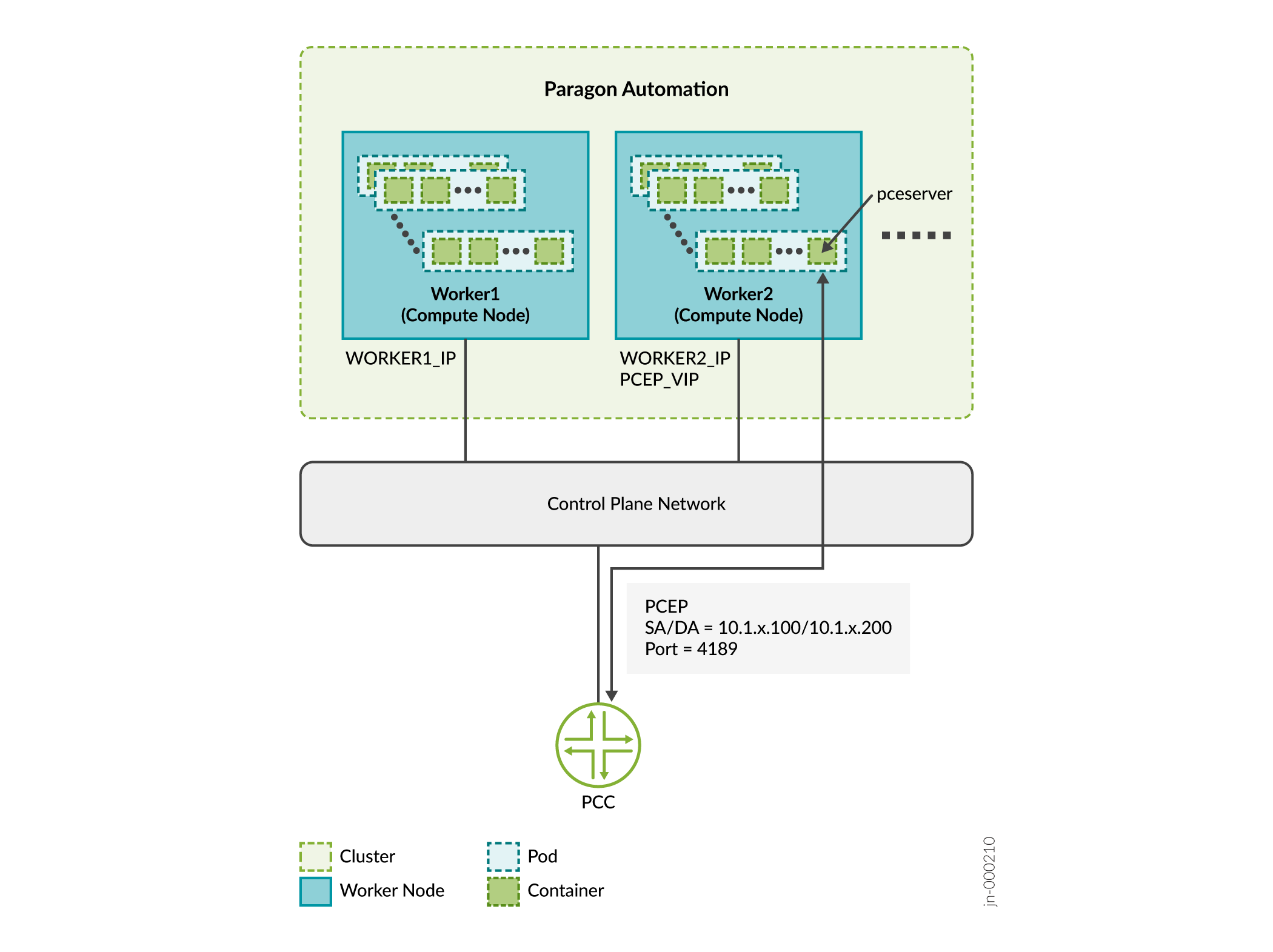
In this example:
Consider that WORKER1_IP = 10.1.x.3 and WORKER2_IP = 10.1.x.4.
SERVICE IP = PCEP VIP = 10.1.x.200
PCC_IP = 10.1.x.100
The services in Paragon Automation are configured to employ one of two methods of exposing services outside the cluster:
-
Load Balancer—Each load balancer is associated with a specific IP address and routes external traffic to a specific service in the cluster. This is the default method for many Kubernetes installations in the cloud. It supports multiple protocols and multiple ports per service. Each service has its own load balancer, and IP address.
-
Paragon Automation uses the MetalLB load balancer. MetalLB simulates external load balancer by either managing virtual IP addresses in Layer 2 mode, or interacts with external router(s) in Layer 3 mode. MetalLB provides load-balancing infrastructure to the kubernetes cluster.
Services of type "LoadBalancer" will interact with the Kubernetes load-balancing infrastructure to assign an externally reachable IP address. Some services can share an external IP address.
-
Ingress—Ingress acts as a proxy to bring traffic into the cluster, then uses internal service routing to route the traffic to its destination. Under the hood, Ingress also uses a Load Balancer service to expose itself to the world so it can act as that proxy.
Paragon Automation uses:
- Ambassador
- Nginx
Devices from outside the cluster need to access the following services and thus these services require a VIP address.
| Required VIP Address | Description | Load Balancer/Proxy |
|---|---|---|
|
Ingress controller |
Used for Web access of the Paragon Automation GUI. Paragon Automation provides a common Web server that provides access to the components and applications. Access to the server is managed through the Kubernetes Ingress Controller. Ingress Controller also provides access for device initiated NETCONF connections. To allow for separation of network element initiated traffic and management traffic, Ingress Controller can be configured using multiple addresses. |
Ambassador MetalLB |
|
Paragon Insights services |
Used for Insights services such as syslog, DHCP relay, and JTI. |
MetalLB |
|
Paragon Pathfinder PCE server |
Used to establish PCEP sessions with devices in the network. PCE server can use Nginx as a proxy, in which case it will not use its own VIP address. |
MetalLB |
|
SNMP trap receiver proxy (Optional) |
User for the SNMP trap receiver proxy only if this functionality is required. |
MetalLB |
|
Virtual IP address for Infrastructure Nginx Ingress Controller |
Used as a proxy for Paragon Pathfinder netflowd server, and optionally Paragon Pathfinder PCE server. The Nginx Ingress Controller needs a VIP within the MetalLB load balancer pool. This means that during the installation process you need to include this address as part of the LoadBalancer IP address ranges that you will be required to include while creating the configuration file. |
Nginx MetalLB |
|
Virtual IP address for Pathfinder Netflowd |
Used for Paragon Pathfinder netflowd server. Netflowd can use Nginx as proxy, in which case it will not require its own VIP address. |
MetalLB |
| Paragon External Registry Virtual IP address (Optional) | Used for connecting to multiple external registry nodes. |
- |
Ports used by Ambassador:
-
HTTP 80 (TCP) redirect to HTTPS
-
HTTPS 443 (TCP)
-
Paragon Planner 7000 (TCP)
-
DCS/NETCONF initiated 7804 (TCP)
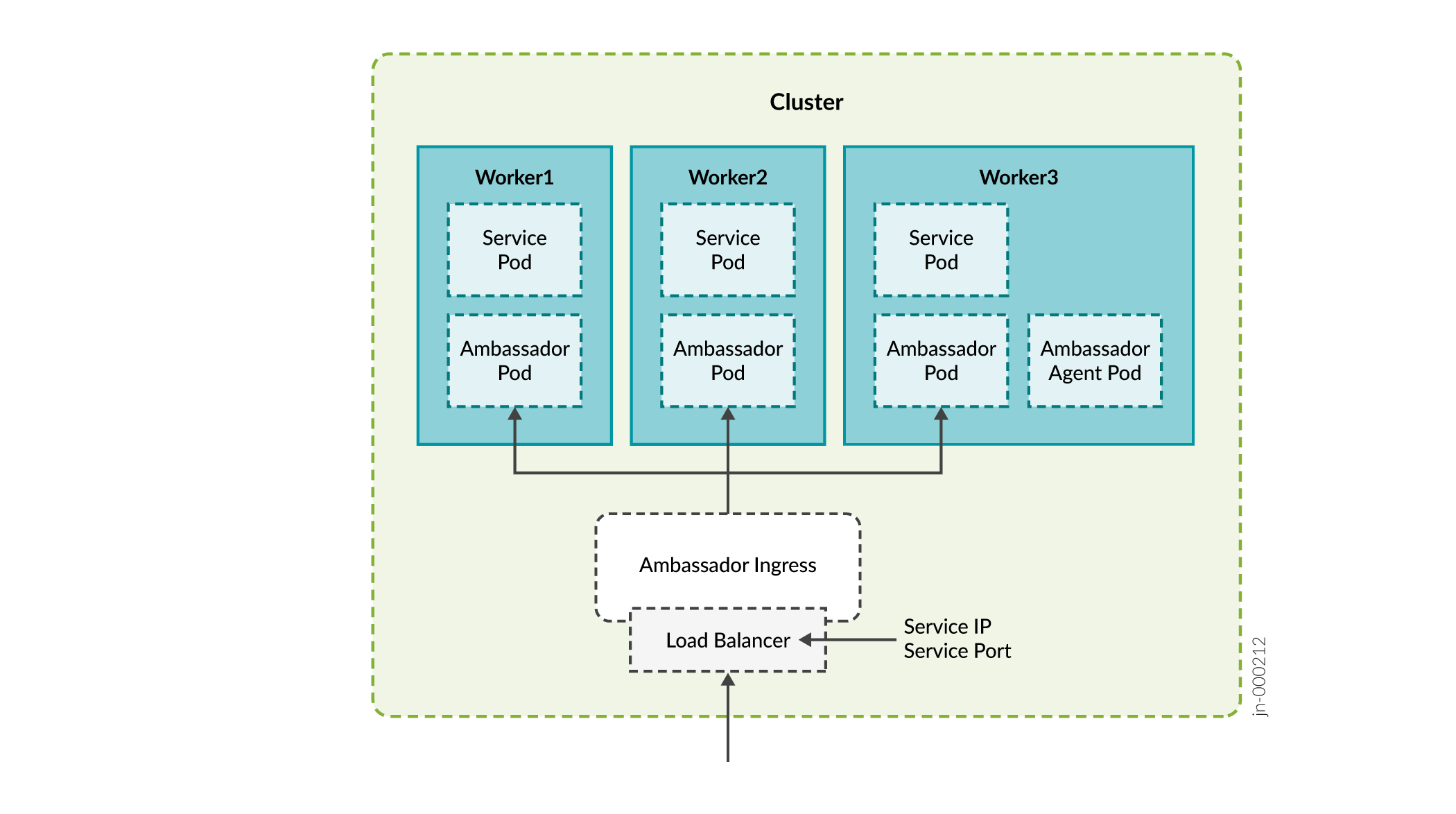
Ports used by Insights Services, PCE server, and SNMP.
-
Insights Services
JTI — 4000 (UDP)
DHCP — (ZTP) 67 (UDP)
SYSLOG — 514 (UDP)
SNMP proxy — 162 (UDP)
-
PCE Server
PCEP — 4189 (TCP)
-
SNMP
SNMP Trap Receiver — 162 (UDP)
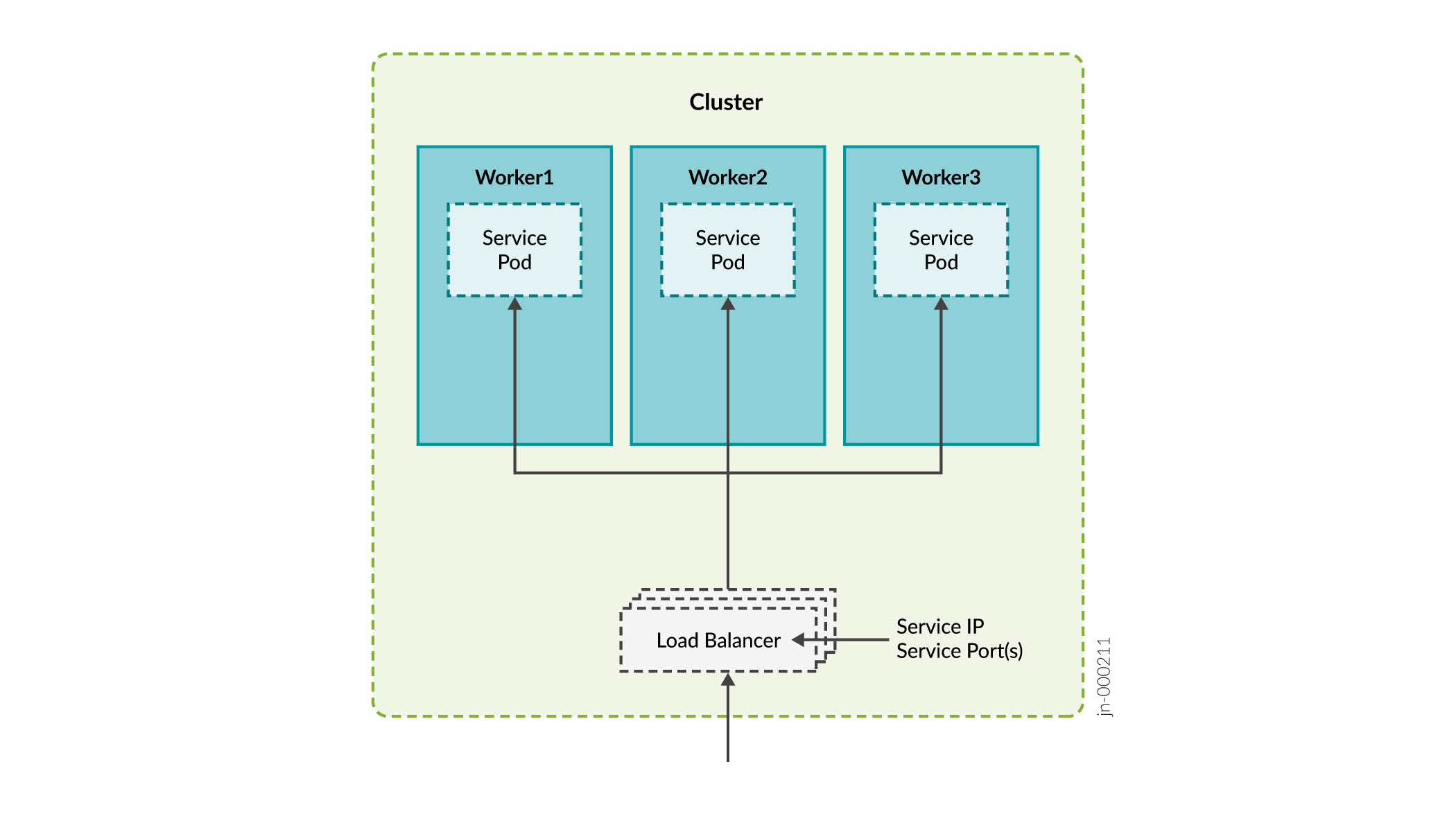
Ports used by Nginx Controller:
-
NetFlow 9000 (UDP)
-
PCEP 4189 (TCP)
Using Nginx for PCEP
During the installation process, you will be asked whether you want to enable
ingress proxy for PCEP. You can select from None or
Nginx-Ingress as the proxy for the Path Computation
Element (PCE) server.
If you select Nginx-Ingress as the proxy, you do not
need to configure the VIP for the PCE server described in the table. In this
case, the VIP address for Infrastructure Nginx Ingress Controller is used
for the PCE server also. If you choose to not use a netflowd proxy, the VIP
for the Infrastructure Nginx Ingress Controller is used for netflowd, as
well.
The benefit of using Nginx is that you can use a single IP address for multiple services.
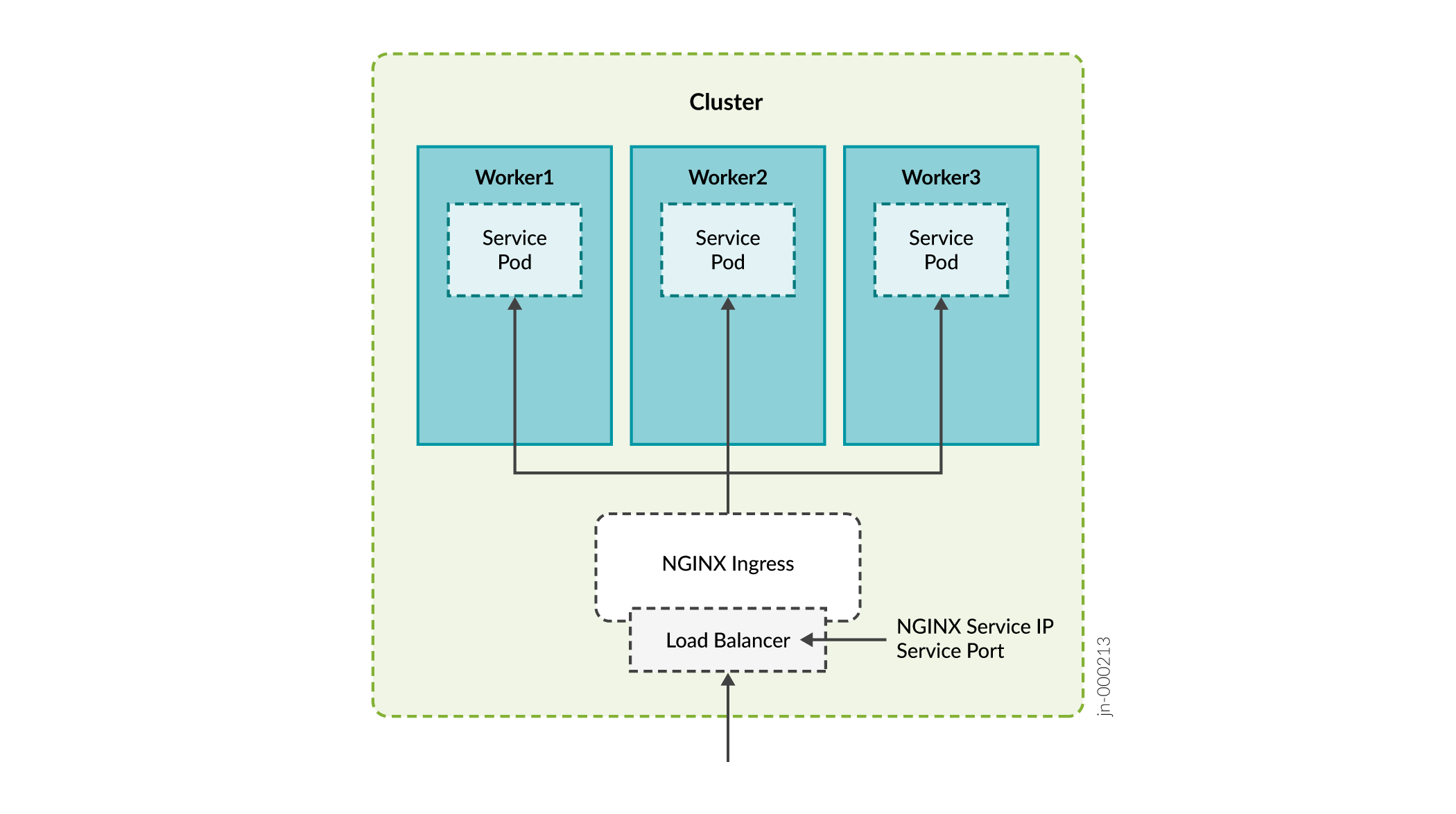
VIP for multi-primary node deployment
If you are deploying a setup with multiple primary nodes, you need an additional VIP address in the same broadcast domain as the cluster nodes. This address will be used for communication between the elected primary node and the worker nodes.
In a multi-primary setup, the worker node communicates with the primary function using the VIP address, instead of the address assigned to any of the nodes acting as primary.
The installation wizard refers to this IP address as the Kubernetes Master Virtual IP address. The VIP address pool of the MetalLB load balancer must not contain this VIP address.
In a setup with a single primary node, the worker node communicates with the primary node using the address assigned to that node acting as primary (IP address configured on the interface of the node acting as primary).
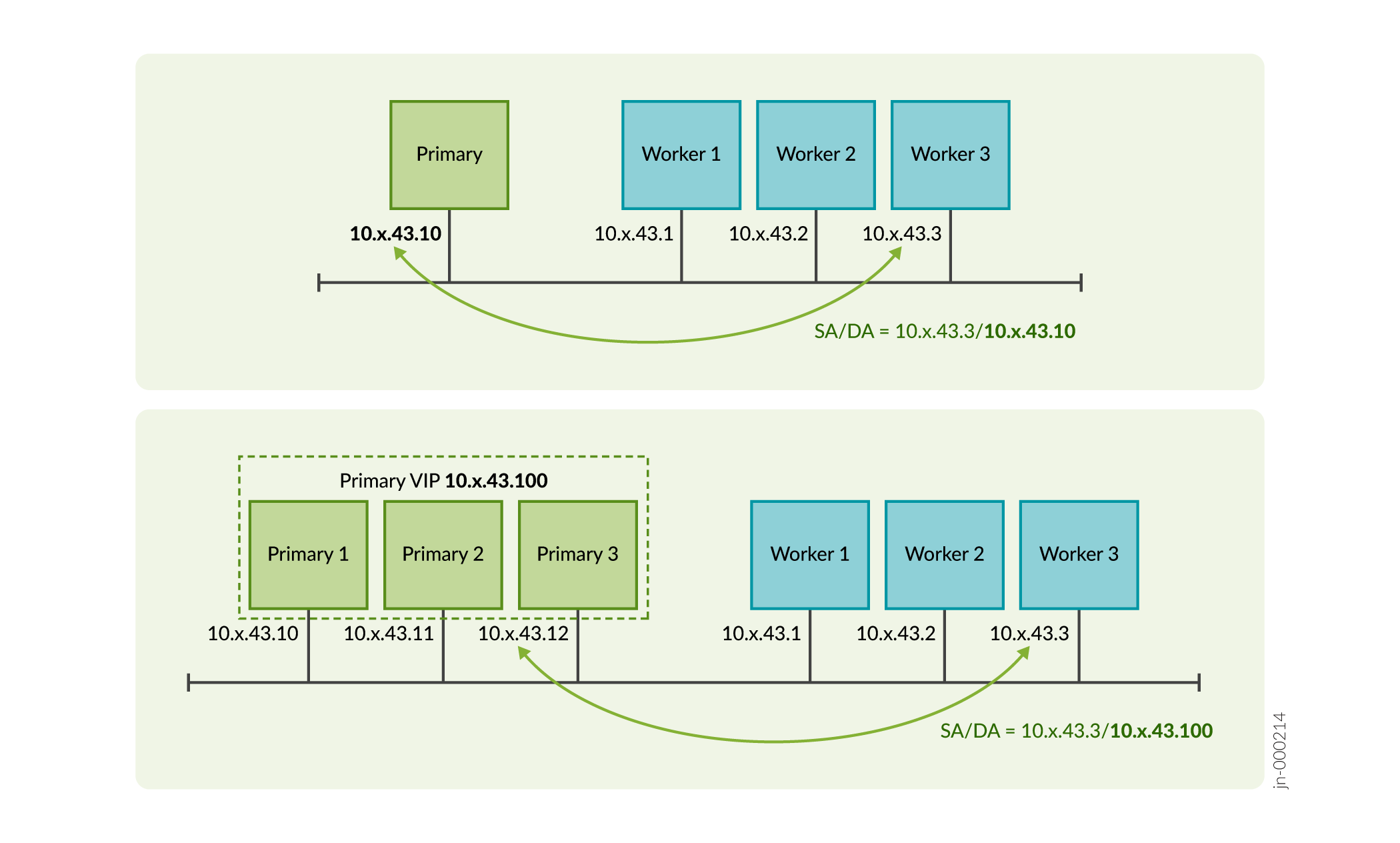
You must identify all the required VIPs, before you start the Paragon Automation installation process. You will be asked to enter these addresses as part of the installation process.
Load balancing configuration
VIPs are managed in Layer 2 by default. When all cluster nodes are in the same broadcast domain, each VIP is assigned to one cluster node at a time. Layer 2 mode provides fail-over of the VIP and does not provide actual load balancing. For true load balancing between the cluster nodes or if the nodes are in different broadcast domains, you must configure load balancing in Layer 3.
You must configure a BGP router to advertise the VIP to the network. The BGP router should be configured to use ECMP to balance TCP/IP sessions between different hosts. Connect the BGP router directly to the cluster nodes.
To configure load balancing on the cluster nodes, edit the config.yml file. For example:
metallb_config:
peers:
- peer-address: 192.x.x.1 ## address of BGP router
peer-asn: 64501 ## autonomous system number of BGP router
my-asn: 64500 ## ASN of cluster
address-pools:
- name: default
protocol: bgp
addresses:
- 10.x.x.0/24In this example, The BGP router at 192.x.x.1 is responsible to advertise reachability for the VIPs with the 10.x.x.0/24 prefix to the rest of the network. The cluster allocates the VIP of this range and advertises the address for the cluster nodes that can handle the address.
DNS Server Configuration (Optional)
You can access the main Web gateway either through the ingress controller's VIP address or through a hostname that is configured in the Domain Name System (DNS) server that resolves to the ingress controller's VIP address. You need to configure the DNS server only if you want to use a hostname to access the Web gateway.
Add the hostname to the DNS as an A, AAAA, or CNAME record. For lab and Proof of Concept (POC) setups, you can add the hostname to the /etc/hosts file on the cluster nodes.
